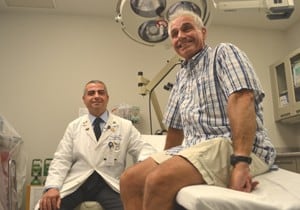UAMS Throat Cancer Patient First for Robotic Surgery
Removing the small tumor the traditional way would require a risky, disfiguring operation, said Emre Vural, M.D., a head and neck cancer surgeon in the UAMS College of Medicine’s Department of Otolaryngology-Head and Neck Surgery. The only way to reach it was by sawing the entire lower jaw in half. “It’s a disfiguring operation and it requires quite a bit of reconstructive work,” Vural said, noting that patients salivary glands and bite can be affected, which may lead to long-term problems chewing and swallowing. “Even if everything goes well, patients are left with a big scar, they need many weeks to recover, and it’s painful.” For Longinotti, 55, Vural proposed a much less invasive alternative: a robotic surgery that would allow the tumor to be removed by working from inside the mouth. Vural was recently certified for the procedure on the da Vinci Surgical System robot. If Longinotti followed Vural’s recommendation, he would be the first patient at UAMS and in Arkansas to have a transoral robotic throat cancer surgery. Longinotti, a residential remodeling contractor who lives in Bryant, said he didn’t hesitate to say yes to the robotic procedure. “I had total confidence in Dr. Vural; the guy is great,” said Longinotti, who also has multiple sclerosis. “He shoots straight with me, doesn’t treat me like a number, and I appreciate that. It was clear to me that he knew what he was doing.” The robotic surgery, performed in just 26 minutes, went exactly as planned. With Vural sitting at the robot’s console a few feet from the patient, he used his fingers to manipulate the robot’s surgical instruments inside the cramped confines of the throat. The clinical stage 4 tumor, which was less than 2 centimeters, was removed as precisely as if in a traditional open surgery. “This is a significant advance in head and neck cancer surgery, and it’s exciting to have instruments with the same range of motion as the wrist and fingers to allow us to remove tumors like this through the mouth,” Vural said. “In addition to avoiding a highly morbid open surgery, this patient will avoid chemotherapy, and that was our ultimate goal.” Longinotti returned to work a week after surgery. In contrast to patients who have the traditional surgery and can’t chew or swallow for months, Longinotti was eating steak just two weeks after his procedure. “The robot is the way to go if you want a fast recovery time,” he said. “I’ve been going 90 to nothing since about the 10th day after surgery.” Longinotti added that his entire experience at UAMS has been extraordinary under the circumstances. “I’m very pleased with the whole hospital; Dr. Vural, the nurses, everyone,” he said. “I tell everyone, if I get an ingrown toenail, I’m going nowhere but UAMS. I believe in that place.” |
